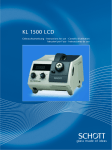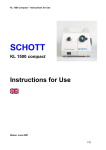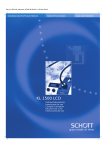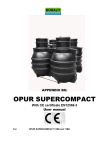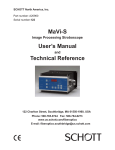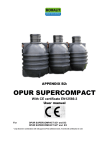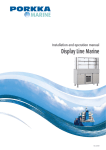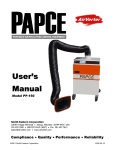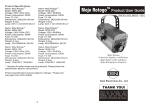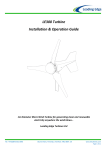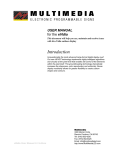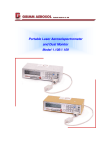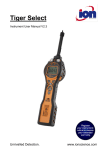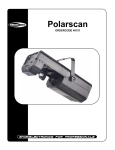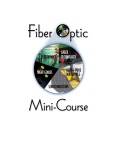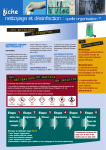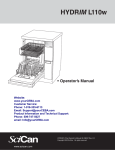Download KL 2500 LCD
Transcript
FIBER OPTICS COLD LIGHT SOURCES KL 2500 LCD Gebrauchsanweisung Instructions for use Conseils d’utilisation Istruzioni per l’uso Instrucciones de uso USER MANUAL KL 2500 LCD For recycling information please visit www.schott.com/fiberoptics/recycle KL 2500 LCD 9 5 15 6 14 12 4 3 2 7 10 11 13 1 17 16 8 18 19 Übersicht LCD-Anzeige Overview of the LCD display Vue d’ensemble de l’affichage LCD Display a cristalli liquidi Detalle de la visualización por cristal líquido 20 21 22 Instrument overview 1 Mains electricity switch 2.2 2 Light guide connection 2.1 3 Electronic light intensity setting 2.3 4 Mechanical light intensity setting 2.3 5 LCD display 6 Lever for supplementary optics 2.4 7 Filter wheel 2.5 Connection socket for remote operation and/or inclination angle switch 2.6 8 9 13 Carrying handle 10 Lamp compartment with halogen cold light reflector lamp 3 11 Button lamp compartment 3 12 Mains cable 13 Ventilation opening (front of instrument) 1 14 Ventilation opening (side of instrument) 1 15 Air outlet grill (back of instrument) 1 16 Fuse (base of instrument) 5 17 Model plate (base of instrument) 18 Color temperature display 2.3 19 Fault status display 5 20 Indication of maximum light intensity 2.3 21 Indication of “STAND-BY” Modus 2.6 22 Indication of connected remote control 2.6 1 Important information Symbols used: Warning of danger (caution, obey documentation) Warning of a hot surface Instrument of Protection Class II Off (disconnected from mains) On (connected to mains) Indication of maximum light intensity Intended use: The cold light source KL 2500 LCD is intended for industrial and laboratory applications. Cold light sources are used for the intensive illumination of all types of objects. The infrared components in the lamp radiation are filtered out. High intensity visible light is guided to the object through flexible or selfsupporting, movable light guides. The unit is tested and certificated to the applicable standards on electrical laboratory equipment (DIN EN 61010-1 and UL 3101-1) and to the standard on medical electrical equipment (EN 60601-1 and UL 2601-1). ➧ Never cover up the open clamping sleeve or the light guide exit (danger of fire). ➧ Never cover up the open clamping sleeve or the light guide exit with your hand or other part of the body (danger of burns). ➧ When illuminating heat-sensitive or flammable light-absorbing objects (e.g. in microscopy), special care must be taken to ensure that a suitable light guide separation distance and lamp brightness are chosen so that no thermal damage occurs. ➧ the lamp has cooled down before it is changed; to remind you, a warning symbol is attached to the lamp compartment door: GB (warning of hot surface); ➧ the filter wheel has cooled down before being removed. It carries the warning symbol; ➧ the light source is operated exclusively with the filter wheel inserted. The filter wheel must always be in one of the five locking positions. ■ The light source has been developed ➧ When the light source is switched on, all light guide exits not being used in the working procedure must always be at a safe distance – at least 10 cm – from heat-sensitive or flammable light-absorbing materials (prevention of possible danger of fire). Therefore take care that each light guide exit is at the above safe distance from, for example, dark/ colored textiles and dark/colored wood or plastics surfaces. ➧ To avoid unnecessary stressing of biological tissue by illumination with visible light, reduce the brightness and duration of illumination to the absolute minimum required level. for operation in dry rooms only (see point 7 “Technical Data”). ■ Contact with cleaning solvents and desinfectants as well as oils and oil/air mixtures can induce tension cracks in the light source body. Therefore direct contact with these substances must be absolutley avoided. ■ This instrument is not suitable for operation in areas where there is an explosion hazard. ■ Safe disconnection from the power supply takes place also by pulling out the mains plug. ■ The instrument must not be opened Safety information: Please read and obey these instructions carefully. The instrument’s safety cannot be guaranteed if they are not obeyed. Avoid looking directly into the open clamping sleeve or the light guide exit when the light source is switched on. The KL 2500 LCD emits high-intensity visible light. Because light-absorbing materials have the physical property of converting incident light into heat, damage can occur to heat-sensitive or flammable light-absorbing materials. To avoid such thermal damage and the potential danger of fire or burns, please obey the following instructions: It is absolutely essential that you ensure that: ➧ your KL 2500 LCD light source is operated at the voltage stated on the model plate (17); ➧ all ventilation openings (13, 14, 15) are kept free. In the event of insufficient cooling, a built-in thermostatic switch switches the instrument off temporarily (see point 5 “Troubleshooting”); or dismantled. Technical modifications to the instrument are forbidden. Repairs must be carried out only by the manufacturer or by its authorised customer service agencies. ■ Please ensure that every user of the instrument has quick access to these instructions. ■ The manufacturer is not liable for damage caused by failure to obey these instructions. ➧ the lamp has cooled down before it is changed; to remind you, a warning symbol is attached to the lamp compartment door: (warning of hot surface); 14 2 Operation 2.1 Light guide connection 2.2 Start-up procedure 2.3.1 Electronic adjustment First open the light guide socket (2) by turning the outer black ring in a counter-clockwise direction. To connect light guides with an 18 mm sleeve diameter, remove the socket adapter. Push the light guide in as far as the stop and close the light guide socket. Switch on/off by operating the mains switch (1). The brightness can be adjusted steplessly by turning the light intensity setting knob (3). There are four distinct notched positions between the two end positions of the adjusting knob. These fixed positions, thus ensure the reproducibility of pre-selected brightness settings. Position : The instrument is switched off. Position I : The instrument is switched on. To protect the halogen lamp the KL 2500 LCD is fitted with a gentle start-up device that reduces the high switch-on current that would otherwise occur. In addition, electronic stabilisation of the lamp voltage ensures stable light power regardless of fluctuations in the mains voltage. ▼ ▼ ▼ Caution: When inserting light guides with a location pin, care must be taken to ensure that the latter fits into one of the four clamping clip slots. Position 1 gives the lowest light intensity, and maximum brightness is attained in position 6. The two barriers at positions 4 and 5 are bypassed by pressing in the adjustment knob. The socket adapter becomes hot during operation. Please ensure that it has cooled down before removal. 2.3 Light intensity setting The adjustment knob cannot be turned beyond the end stops 1 and 6 respectively. The KL 2500 LCD is fitted with two independent alternative means to adjust the light intensity. The lamp lifetime in position 4 is about 1500 hours and in position 5 it is about 150 hours. The stepless electronic adjustment enables you to optimise the lamp lifetime - by precisely setting the brightness you require, you will achieve the longest halogen lamp lifetime that is possible for your application. This also varies the color temperature of the emitted light. In position 6 the halogen lamp is operated at its nominal voltage and the lamp will achieve approximately the rated lifetime stated by the lamp manufacturer (depends upon the type). ▼ To remove the adapter, first of all completely unscrew the black ring. Then slightly press the adapter together at the positions marked and remove it. Insertion of the adapter takes place in the reverse sequence. The mechanical adjustment enables stepless variation of the light intensity at a constant color temperature. 15 The approximate color temperature of the light emitted by the halogen lamp (18) is indicated on the LCD display (5). The color temperature of the light can be set by turning the light intensity adjustment (3) (step width 50 K). After bypassing the barrier at position 5, a lamp symbol (20) appears in the LCD display and flashes for the first few seconds. This acts as a maximum light indication and gives a warning that the expected lamp lifetime will be reduced compared to position 5. 2.3.2 Mechanical aperture 2.4 Supplementary optics The light intensity can be altered steplessly while retaining the color temperature by turning the adjustment knob of the mechanical aperture (4). Two fixed end-stops and three additional retention points (marked with the letters A to E) enable defined aperture settings to be selected reproducibly. Use of the supplementary optics ensures that uniform, high-intensity illumination is achieved even when using light-guides with a smaller bundle diameter. ▼ GB If the illumination is carried out with imaging or focussing optical systems at the light guide exit, optimally uniform illumination is achieved by moving the supplementary optics out of the optical path. Position - Supplementary optics in optical path: uniform illumination with no optical systems at the light guide exit. ▼ Position - Supplementary optics out of optical path: uniform illumination with optical systems at the light guide exit. The supplementary optics must always be positioned at the end stop. Position A gives the lowest brightness, and maximum brightness is achieved in position E (aperture completely open). Turning the adjustment knob from one retention point to the next approximately doubles or halves the light intensity respectively each time. ▼ The adjustment knob cannot be turned beyond the end-stops A and E respectively. 16 2.5 Filter wheel 2.5.1 Fitting the Filter 2.6 Remote control connection The KL 2500 LCD has a filter wheel (7) which can be fitted with a maximum of 5 filters. Please ensure the light care to ensure that the light source is switched off and has cooled down before removing the filter wheel. There is a warning symbol to remind you. A remote control and/or inclination angle switch (accessories) can be connected to the light source via the connection socket (8). Different color and fluorescence excitation filters (available as accessories) can be brought into the optical path by turning the ridged edge of the filter wheel. Please ensure that the filter wheel is always engaged in one of the predefined rest positions. Operating the light source with the filter wheel in an intermediate position can cause the wheel to overheat. The ridged edge of the filter wheel has position markings (the corresponding number of raised marks identifies positions 0 to 4). ▼ ▼ To remove the filter wheel, take hold in the depression on the underside of the carrier, pull it out to the stop, lift slightly and then carefully remove. To fit filters into the wheel, remove the cross-head screw and remove the plate holding the filter in place. Insert the filter into the wheel. Push on the plate and tighten the screw. Insert the filter wheel into the guide and push it into the cold light source until it engages. Please ensure that your KL 2500 LCD is operated exclusively with the existing filter wheel. This is the only way to guarantee optimum air cooling of the light source. The indication “REMOTE” (22) appears in the LCD display when the remote control is plugged in. The remote control can electronically set the light intensity, thus putting the light intensity control knob (3) temporarily out of operation. Both the remote control and the inclination angle switch provide a facility to put the light source into “STAND-BY” mode to protect the halogen lamp. A corresponding indication (21) appears in the display. ▼ Please note the following: 17 In “STAND-BY” mode the appliance is not disconnected from the mains electricity supply. The remote control (or the inclination angle switch) should only be connected and disconnected when the appliance is switched off. 3 Replacing the lamp 4 Maintenance 5 Troubleshooting Please ensure that the lamp and lampholder have cooled down before replacement. The corresponding warning symbol is attached to remind you. Your KL 2500 LCD is maintenance-free. The display has a fault status indicator (19). Any possible breakdowns can be recognized quickly and easily. ▼ To clean the outside of the instrument, use a soft dry cloth or commercially available plastic cleaning cloths. Contact with cleaning solvents and desinfectants as well as oils and oil/air mixtures can induce tension cracks in the light source body. Therefore direct contact with these substances must be absolutley avoided. GB „Err 1“: Lamp circuit interrupted. „Err 2“: Temperature monitor has triggered. „Err 3“: Short-circuit in the lamp circuit, electronic fuse has triggered. ▼ First of all switch off the light source. Open the lamp compartment (10) by pressing the button (11) and pull it out as far as the stop. Press down the two levers of the special socket and pull out the faulty lamp. The two levers must be pressed down again while inserting the new lamp. Push the lamp compartment in until it latches (audible locking sound). Switch the light source on. Fault Possible causes Remedial action Lamp out, fan not running, no LCD display Instrument not switched on. Switch instrument on. Plug not in socket. Plug the plug in. No mains electricity voltage. Check mains voltage. Lamp compartment not closed. Close lamp compartment. Fuse faulty. Replace fuse (16). Transformer overheated. Ensure adequate cooling, check that lamp type is correct, re-start instrument after cooling down for a prolonged time. Remote control or inclination angle switch faulty. With instrument switched off, disconnect accessories Lamp out, fan running, fault status indication „Err 1“ Lamp defective. Replace lamp (see point 3 of these instructions). No lamp. With light source switched off, install lamp. Lamp out, fan running, fault status indication „Err 2“ Insufficient cooling. Ensure ventilation apertures are free, avoid excessive ambient temperatures, the instrument will switch back on again after a short time. Lamp out, fan running, fault status indication „Err 3“ Transient current increase in lamp circuit. Switch instrument off and, after a few seconds, back on again. Lamp causing short-circuit. Replace lamp (see point 3 of these instructions). If you are unable to rectify the fault by the actions mentioned above, please contact your specialist dealer or the nearest SCHOTT agency. More extensive repairs must be carried out by the authorised customer service depot. 18 6 Accessories A wide range of accessories is available for your KL 2500 LCD. A separate brochure gives you comprehensive information – to get it see addresses overleaf. Only SCHOTT light guides and accessories guarantee perfect operation, safety and optimum light yield. 6.4 Remote control 6.5 Inclination angle switch The following functions can be controlled by remote control: The inclination angle switch switches the light source into the “Light on” or “STAND-BY” modes depending on its angle of inclination relative to the ground. Inclination angle switches are mounted, for example, on the freely mobile arm of diagnosis microscopes. Both the remote control and the inclination angle switch have a connection cable 3 m long as standard. A cable splitter enables a remote control and inclination angle switch to be operated simultaneously. Please consult the instructions enclosed with the respective device for detailed information on the remote control and inclination angle switch. • Light on/off (“STAND-BY”) • Electronic light intensity adjustment 6.1 Light guides Self-supporting and flexible light guides in various lengths and diameters are available, as well as point and slit illuminators. 6.2 Halogen lamps When ordering halogen lamps as spare parts (see point 6.6 of this instruction), the lamp type that enables optimum light yield and illumination will be supplied. 6.3 Filters Optical filters can either be inserted into the filter wheel (7) or placed in front of the light guide exit as a screwin or push-on filter in conjunction with an auxiliary focussing device (accessory). Details of the auxiliary focussing device and the filter types available as standard can be found in the accessories catalogue. 6.6 Spare parts Spare part Catalogue No. Halogen lamp 24 V/250 W Osram, type HLX 64653 Philips, type 13163 253 000 Fuse for 230 V (primary) T 3,15 H, 250 V acc. to IEC 127-3/5 253 101 Fuse for 120 V (primary) M 6,3 A acc. to UL 198 G 253 103 To ensure maximum performance, light yield and safety you must only use the spare parts stated above. 7 Technical data Properties Values General information Type description Dimensions (W x D x H) mm Weight kg Cooling - KL 2500 LCD approx. 200 x 265 x 170 approx. 6 axial (fan cooled) Ambient temperature* °C + 5 ... + 40 Relative air humidity* % at 31°C ambient temperature: 85 % from 31°C to 40°C ambient temperature: decreasing linearly to 75 % Air pressure* hPa 700 ... 1060 Transport and storage Temperature Rel. air humidity Air pressure °C % hPa - 40 ... + 70 10 ... 95 (non-condensing) 500 ... 1200 Contamination level - 2 * Test conditions of Standards DIN EN 61010-1, DIN EN 60601-1 and UL 3101-1. continued on page 20 19 Properties Values Electrical information GB Operating voltage, frequency 230 V version 120 V version 220 ... 240 V ~ 50 / 60 Hz 100 V ~ 50 / 60 Hz and 120 V ~ 60 Hz ± 1.5 % of the set lamp voltage (true RMS value) Electronic stabilisation of the lamp voltage (working range: specified operating voltages ± 10 %) Power consumption, max. W 300 230 V version - 120 V version - T 3,15H,250 V in accordance with IEC 127-3/5 M 6,3 A in accordance with UL198 G Protection class - II Overvoltage category - II Lamp type - Halogen reflector lamp Osram, type HLX 64653 Philips, type 13163 Lamp rated voltage V 24 Lamp rated power W 250 Average lamp lifetime Level 4 Level 5 Level 6 h h h 1500 150 50 Fuses, primary Lighting information Maximum effective light guide bundle diameter Total light flux at light guide exit (SCHOTT light guide, Ø 15 mm, typ. values) Level 4 Level 5 Level 6 (max. light flux) Light entry angle (2αeff) Without supplementary optics mm lm lm lm degrees Heat protection filter - Approvals 230 V version 120 V version - 15 500 1000 1300 approx. 53 SCHOTT KG 2, 45 x 45 thickness = 2,0 mm, toughened The KL 2500 LCD has been tested and certificated to the applicable standards on electrical laboratory equipment (EN 61010-1 and UL 3101-1) and to the standard on medical electrical equipment (EN 60601-1 respective UL 2601-1). This enables manufacturers to obtain easy approval with integration of the KL 2500 LCD into their medical products. Die 230 V version features . The right is reserved to make changes in the design and supplied items within the scope of on-going technical development. 20











